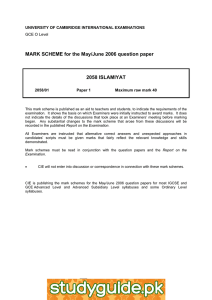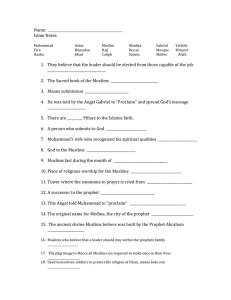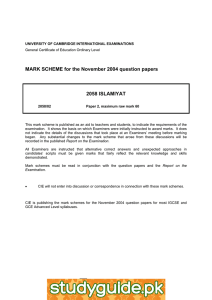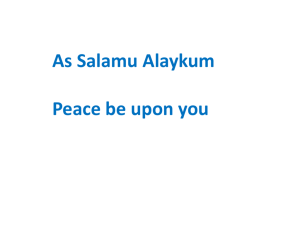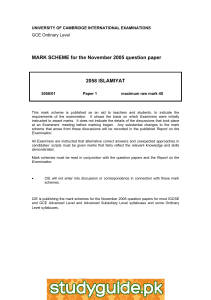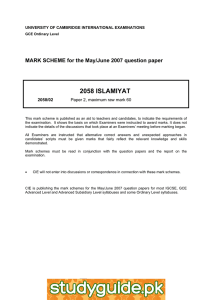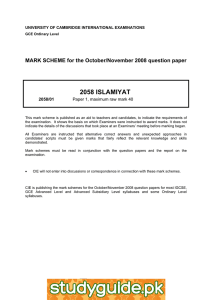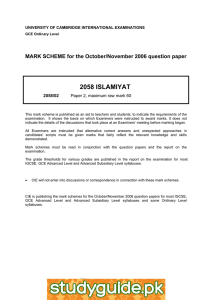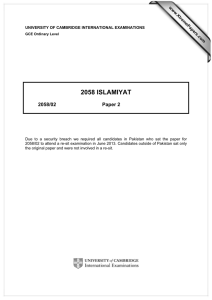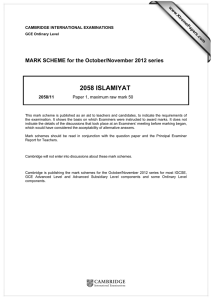MARK SCHEME for the May/June 2006 question paper 2058 ISLAMIYAT www.XtremePapers.com
advertisement
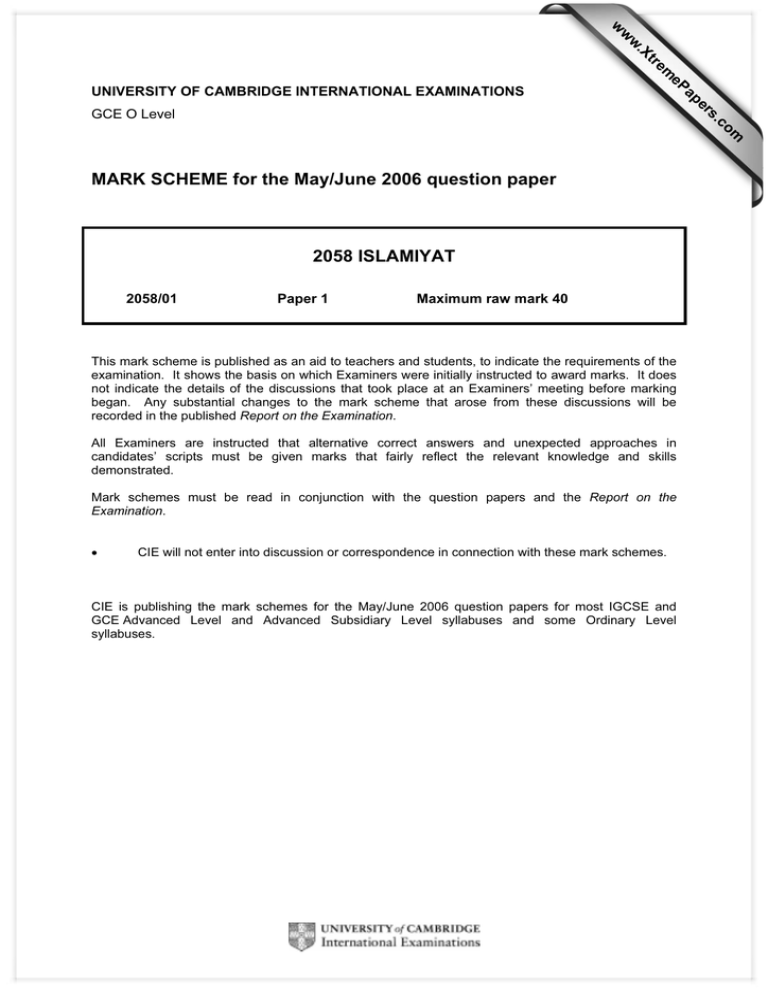
w w ap eP m e tr .X w UNIVERSITY OF CAMBRIDGE INTERNATIONAL EXAMINATIONS s er om .c GCE O Level MARK SCHEME for the May/June 2006 question paper 2058 ISLAMIYAT 2058/01 Paper 1 Maximum raw mark 40 This mark scheme is published as an aid to teachers and students, to indicate the requirements of the examination. It shows the basis on which Examiners were initially instructed to award marks. It does not indicate the details of the discussions that took place at an Examiners’ meeting before marking began. Any substantial changes to the mark scheme that arose from these discussions will be recorded in the published Report on the Examination. All Examiners are instructed that alternative correct answers and unexpected approaches in candidates’ scripts must be given marks that fairly reflect the relevant knowledge and skills demonstrated. Mark schemes must be read in conjunction with the question papers and the Report on the Examination. • CIE will not enter into discussion or correspondence in connection with these mark schemes. CIE is publishing the mark schemes for the May/June 2006 question papers for most IGCSE and GCE Advanced Level and Advanced Subsidiary Level syllabuses and some Ordinary Level syllabuses. Page 1 1 Mark Scheme GCE O Level – May/June 2006 Syllabus 2058 Paper 1 Comment on the main teachings contained in two of the following passages from the Qur'an. [2 x 4] Give up to 4 marks for each answer. Relevant comments will focus on the main teachings in each passage rather than a summary or explanation of separate verses. (a) Sura 2.255 God! There is no god but he, the living, the self-subsisting. Neither slumber nor sleep can seize him. To him belongs whatever is in the heavens and whatever is in the earth. Who will intercede with him except by his leave? He knows what is in front of them and what is behind them, While they encompass nothing of his knowledge except what he wills. His throne extends over the heavens and the earth, And he is never weary of preserving them. He is the sublime, the supreme. • • • • • This verse describes the uniqueness of God. He is One, Supreme, and in total control of the whole of creation. [Allow up to 2 marks for summaries of God’s characteristics.] He is beyond human comprehension. Nothing outside him, such as human pleas, can affect God unless he wills to heed. The throne can be seen to represent God’s power and majesty. (b) Sura 28.30-31 But when he came to it, a voice was heard from the right bank of the valley, from a tree in hallowed ground: “Moses! I am indeed God, the Lord of the worlds.” “Now throw down your rod!” But when he saw it moving, as if it were a snake, he turned back in retreat, and did not retrace his steps. “Moses! Draw near, and do not fear: for you are of those who are secure.” • • • • These verses describe Moses’ call to be a messenger of God. God calls Moses suddenly with no warning, but according to his own will. By causing the miracle of the staff, God demonstrates his power. God makes clear that Moses will be protected from harm because he is his messenger. (c) Sura 107 Have you seen the one who denies religion? He is the one who repulses the orphan, And does not encourage the feeding of the poor. So woe to the worshippers, Who are neglectful of their prayers; Who want to be seen, © University of Cambridge International Examinations 2006 Page 2 Mark Scheme GCE O Level – May/June 2006 Syllabus 2058 Paper 1 But refuse neighbourly needs. • • • • 2 Islam teaches about a just and caring society. It uses the example of hypocrites who do good only to appear to be religious. They fail in the major duties of Islam, especially the duty of caring for others. Muslims should be aware that their actions must be based on sincere belief. (a) Give descriptions of the main events of the battles of Badr and Uhud. (b) Explain why the people of Makka fought against the Muslims of Madina. (a) • • • • • • • • • • • • • • • • (b) • • • • 3 [12] [4] Badr occurred in 624, the second year after the hijra. The Muslims had heard of a Makkan caravan passing near Madina, and they waited for it near the wells of Badr. The caravan summoned troops from Makka. The two armies were badly mismatched, 300 Muslims against over 1000 Makkans. Despite the odds the Muslims won. The Prophet surprised everyone by treating the captured Makkans honourably. The Muslims saw in the victory God’s support for their cause, when he sent angels to help them. Uhud occurred in 625. An army of 3000 from Makka came to destroy the Muslims. The Prophet’s army was smaller, and was decreased further by the desertion of some Madinans. In the fighting the Muslims gained the upper hand. But then some Muslims who had been ordered to guard a pass left their posts for spoils. Some Makkans saw an advantage and attacked from behind. The Muslims were nearly defeated and some leading men killed. The Prophet himself was injured. The Muslims realised they should obey the Prophet. They could see that the Muslims were a threat. They threatened their livelihood since they might attack their caravans. They also threatened their religion with their belief in only one God. They saw Islam as a threat to their leadership in Arabia. Give a brief explanation of the importance of each of the following in Muslim beliefs and practices in relation to the hajj: (a) the Ka’ba; [4] (b) ihram; [4] (c) ‘Arafat; [4] and (d) ‘Id al-Adha. [4] © University of Cambridge International Examinations 2006 Page 3 Mark Scheme GCE O Level – May/June 2006 Syllabus 2058 Paper 1 In each part candidates must refer to both beliefs and practices in order to gain full marks. (a) • • • • • • (b) • • • • • Ihram is the state of purity which Muslims enter when beginning the pilgrimage. The chief sign is for men two pieces of white cloth worn around them. For women it is normal clothes covering the whole body except face and hands. It removes signs of distinction and makes all pilgrims appear equal. In the state of ihram the pilgrim comes under particular restrictions of conduct, such as no cutting of hair or nails. (c) • ‘Arafat is the plain outside Makka where all pilgrims gather during the annual pilgrimage. Here they perform the wuquf, standing between noon and dusk in order to obtain God’s forgiveness. This is the high point of the pilgrimage, without which it is not valid. Adam and his wife were reunited here after being expelled from the garden. The last judgement will take place here. • • • • (d) • • • • • 4 The Ka’ba was built by Adam, and later restored by Ibrahim and Isma’il, and again in the time of the Prophet. It was the first sanctuary in which God was worshipped. It is the focus of Muslim prayer from all parts of the world. It is the first point in Makka that most pilgrims make for. During pilgrimage Muslims circumambulate it seven times. They try to kiss the Black Stone as they pass it following the Prophet’s example. Muslims celebrate this by slaughtering an animal. They do this in order to remember Ibrahim’s sacrifice of his son. Ibrahim was instructed to make this sacrifice as a sign of obedience. The ‘Id is celebrated at the high point of the annual pilgrimage. All over the world families celebrate this feast by making a sacrifice. (a) Explain the importance of the isnad (chain of transmitters) and of the matn (body of text) in assisting scholars to check the authenticity of a Hadith. [12] (b) Outline the major differences between the musnad and musannaf collections of Hadith. [4] (a) • • • • • • • The isnad guarantees that the Hadith originated with the Prophet. Each transmitter (rawi) must be honest and upright. He must be a strong Muslim. He must have a good memory. Each transmitter must have known the transmitter before him, and also the transmitter after. The first transmitter in the chain must be a Companion of the Prophet. There must be no gaps or weaknesses in the chain. • • • • • • The matn must agree with the teachings of the Qur’an. It must also agree with the main body of reliable Hadiths. It must also agree with common sense and what is reasonable. It should not praise any individual or place. It should not give precise details of events that occurred after the Prophet’s time. It should not contain expressions uncharacteristic of the Prophet. (b) • • • The musnad collections gather Hadiths together according to the name of the first transmitter. They are useful for detecting Hadiths attributed to a particular Companion. The best known musnad collection is Ibn Hanbal’s Musnad. © University of Cambridge International Examinations 2006 Page 4 • • • • Mark Scheme GCE O Level – May/June 2006 Syllabus 2058 Paper 1 The musannaf collections gather Hadiths according to their subject matter. They are useful for understanding the Prophet’s teachings on a particular point of belief or practice. They are particularly useful in establishing matters of law. The six books of Sunni sahih Hadith are the best known musannaf collections. © University of Cambridge International Examinations 2006
